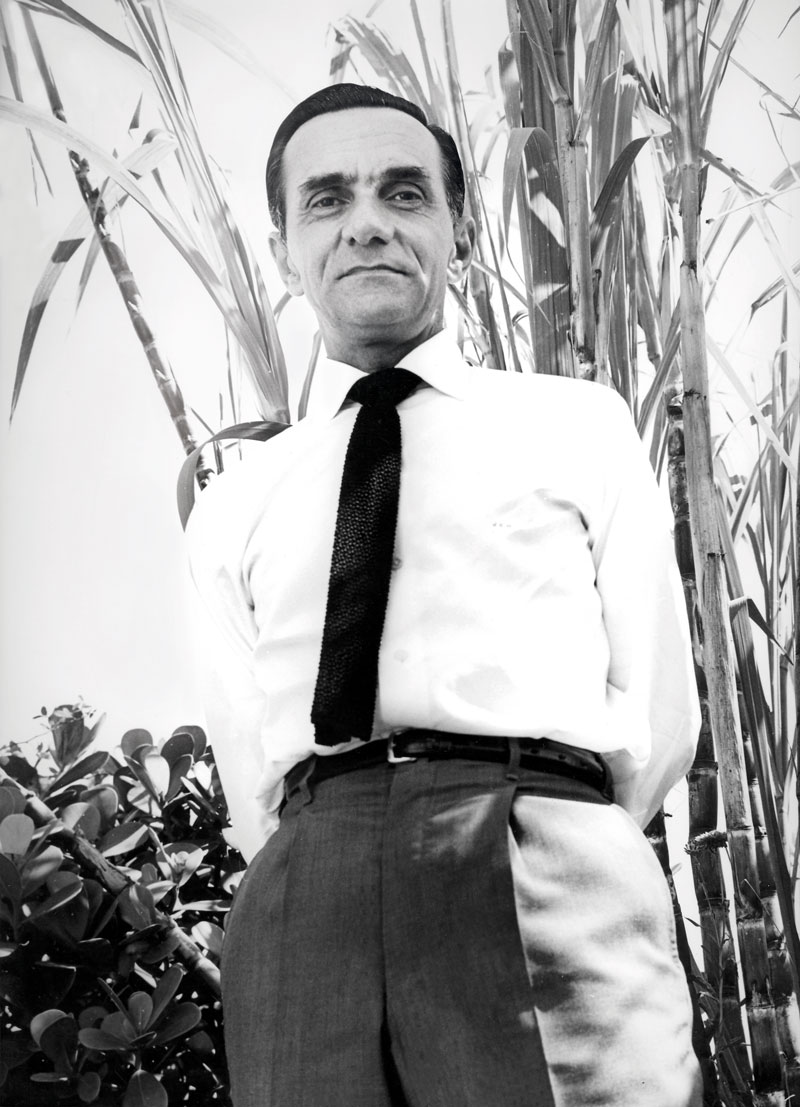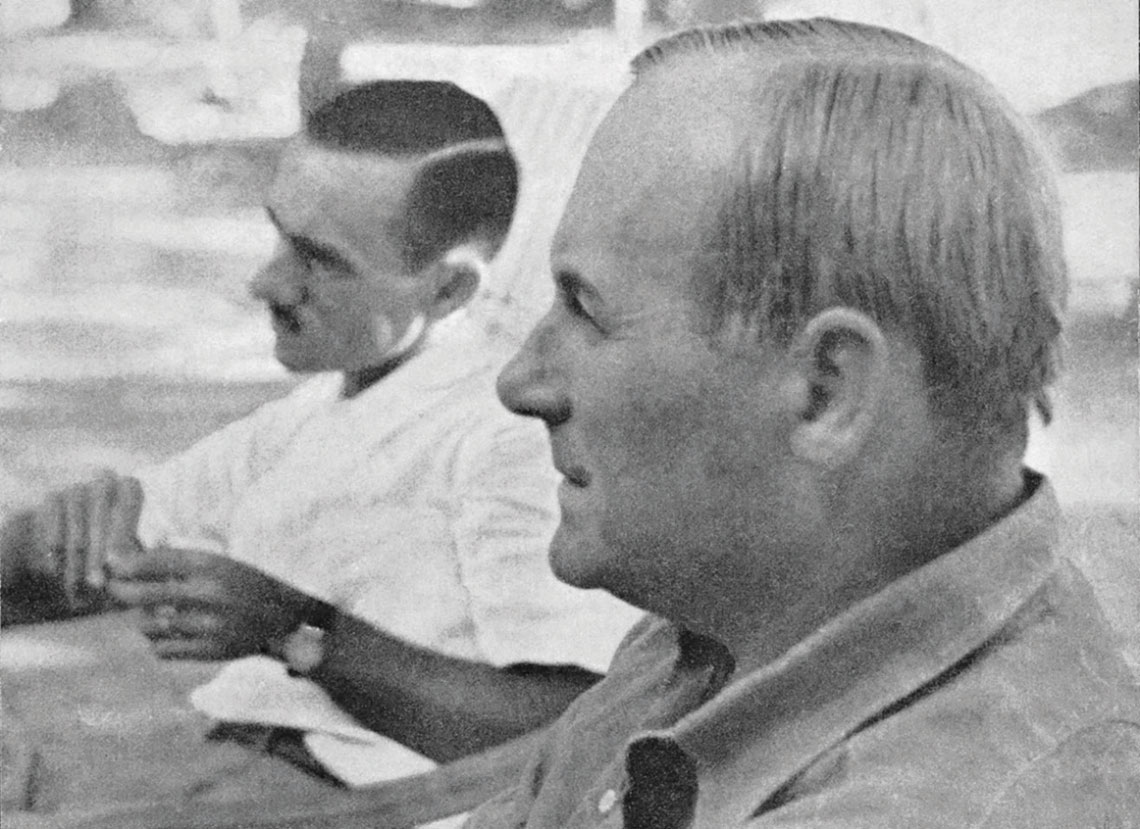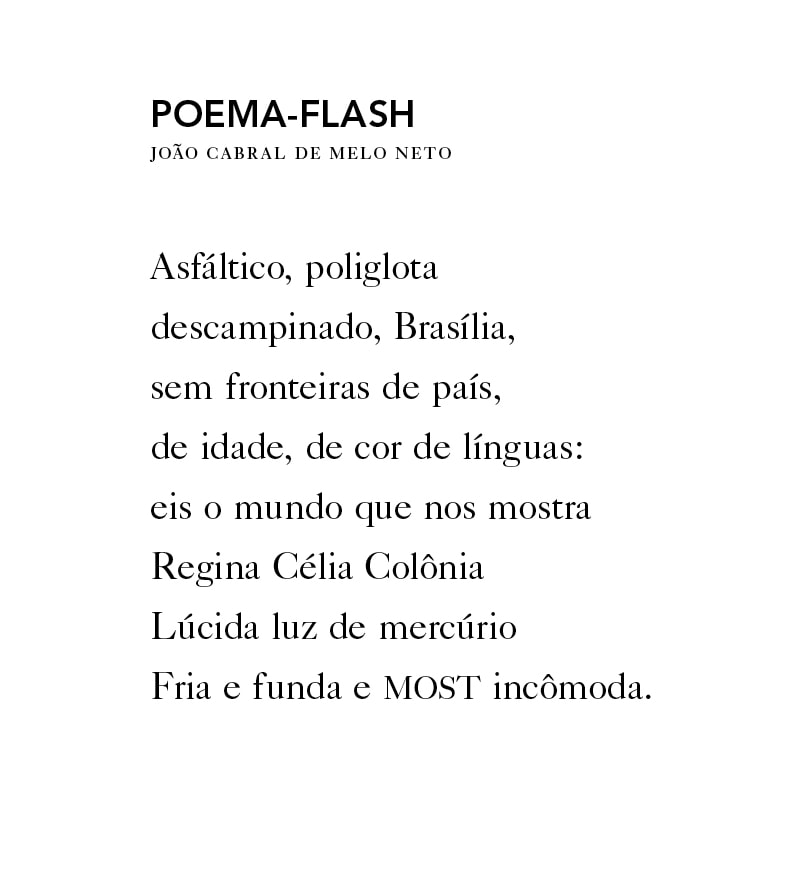
Brazilian Academy of Letters Archive
João Cabral: poems characterized by formal rigor and attention to everyday elementsBrazilian Academy of Letters ArchiveJoão Cabral de Melo Neto was the first to define his own poetry as cerebral, objective, mathematical. He opposed the traditional lyricism of Brazilian poetry and the unchecked expression of emotions, focusing his efforts instead on objective and formally rigorous art. And that was how he created a universe that depicted sugar mills, the Capibaribe river, soccer players, the streets of Seville, modern painters, and classic poets.
“Subjectivity can exist in poetry without an ‘I’ pronoun screaming at the reader,” argues critic Ivan Marques, a professor at the School of Philosophy, Languages and Literature, and Humanities at the University of São Paulo (FFLCH-USP). “When Cabral describes poets, manual laborers, fishermen, he projects a world view. The subjectivity is filtered through the discourse,” he explains. In the work of an author like Cabral, he assesses, the individual’s experiences are neither absent nor camouflaged, but filtered through the craft of language.
The 100th birthday of the Pernambuco poet—who was born on January 6, 1920, in Recife and died in 1999 in Rio de Janeiro—is being celebrated through several releases and events. Marques, who has been conducting research on the author’s work for 10 years, is working on a biography to be published this year by Todavia. Last December, the Joaquim Nabuco Foundation (FUNDAJ) held a seminar in Recife about the parallels between Cabral and sociologist Gilberto Freyre (1900–1987), his cousin who was 20 years his senior. At the event, the Portuguese poet Arnaldo Saraiva illustrated how much Cabral influenced Portuguese modern poetry, particularly the work of Sophia Mello Breyner Andresen (1919–2004).
A new edition of his complete poetic works will be released by Alfaguara in June, edited by Antonio Carlos Secchin, a professor with the Federal University of Rio de Janeiro (UFRJ) who has been studying the work of João Cabral for over 45 years. The new edition includes previously unpublished poems, which were found at the Rui Barbosa House, in Rio de Janeiro, by Edneia Rodrigues Ribeiro, a professor at the Montes Claros campus of the Federal Institute of Education, Science and Technology of Northern Minas Gerais (IFNMG). Ribeiro, whose research on the poet’s personal collection started in 2016, found the poems in late 2018 when she was about to finish her PhD at the Federal University of Minas Gerais (UFMG). “I was barely able to mention the discovery, all the while feeling like my work would be incomplete without those poems,” she recalls.
Ribeiro considers that the poems are “equal to those included in books such as Agrestes (1985), Museu de Tudo (Museum of everything) (1975), A Escola das Facas (The school of the knives) (1980), and others.” However, as the poems themselves have “different thematic and aesthetic approaches,” had they been published, “we would not have a rational, organic collection.” Nowadays, “while some readers believe that publishing these poems does not add much to the already established body of poetry by Cabral, I see no reason to imagine they might compromise the attention to detail that was always present in his poetic work,” she states. The poems are not dated, but some have corrections and notes that suggest they could have been considered for collections of his complete works. Ribeiro believes “this indicates that the author himself lost control over his poems at a certain point.”
A critical edition of the letters exchanged between João Cabral and the Portuguese poet Alberto de Serpa (1906–1992) will also be published this year by UFG. The volume was organized by Solange Fiuza, coordinator of the Language and Linguistics Graduate Program at the Federal University of Goiás (UFG). According to Fiuza, the letters help further illuminate Cabral’s critical thinking; they also reveal details about the writing of O Cão Sem Plumas (The dog without feathers) (1950) and about his political positioning during the second half of the 1940s. “In Franco’s Spain, when he was first stationed as a diplomat, Cabral saw in communism a solution. His letters to Serpa make this position explicit,” explains Fiuza. In addition to the letters and the critical apparatus, the book will also include a facsimile of the only printed issue of the magazine O Cavalo de Todas as Cores (The horse of all colors), published by Cabral and Serpa in 1950 in Barcelona.

Reproduction
João Cabral and Catalan painter Joan Miró became friends in the 1940s in BarcelonaReproductionJoão Cabral de Melo Neto is recognized as one of the most important Brazilian poets of the twentieth century. His influence is so great that critics often call poets by the epithet of “cabralino,” or “Cabralian.” His rigorous metrics, careful word choices, and rejection of lyricism are some of the features that evoke Cabral’s heritage. “Any serious poet, from the second half of the last century onwards, necessarily dialogues with Cabral’s work,” says Marques. “Cabral helped make Brazilian poetry more rigorous, more self-aware; a departure from spontaneous poetry about matters of the heart.”
The so-called Cabralian poetry is one that is “self-conscious of its own craft,” according to Marcos Siscar, a poet and professor at the Institute of Language Studies at the University of Campinas (IEL-UNICAMP). “Some poets, such as Manuel Bandeira, Carlos Drummond de Andrade, and Cabral, left a strong mark on Brazilian poetry. This means their influence is recognizable in the work of later poets,” he states. “Perhaps more than any other, Cabral invented a kind of poetic ‘diction,’ shifting the modernist emphasis to free verse,” explains Siscar.
“João Cabral is to lyric and melodic poetry what the writers of the Modern Art Week of 1922 were to the Parnassian tradition that came before them,” according to Fábio de Oliveira, a professor at the Federal University of Maranhão (UFMA), who has been conducting research on the subject for a decade. “Writing poetry through the lens of objectivity is much less strange today than when João Cabral first did this. Hence the existence of an adjective like Cabralian in reference to the works of other poets,” he adds.
The references to João Cabral’s work are not always accepting of his ideas. Confronting the cabralino style is also a way to dialogue with its heritage. Siscar recalls that, at the turn of the 1980s, Rio de Janeiro poet Ana Cristina César (1952–1983) referred to her own generation as “anti-Cabralian par excellence.” In Siscar’s assessment, the marginal poetry of the time rejected intellectualism and had “a more heterodox and mundane view of poetry.”
While on the one hand João Cabral’s poetry is said to be “cerebral” and “intellectualist,” on the other hand, his social concern is emblematic, to the point that his best-known work is Morte e Vida Severina (The Death and Life of a Severino), published in 1955 with the subtitle A Pernambuco Nativity Play. The text was written at the request of Maria Clara Machado (1921–2001), a director at the Tablado theater in Rio de Janeiro, but it was never staged by her. In 1966, it was put to music by Chico Buarque.
Siscar believes Cabral’s focus on formality and social concern go hand in hand in his works. He recalls that, in the 1952 essay “Poesia e composição” (Poetry and composition), the poet stated that the artist can only dialogue with his contemporaries once he masters the technique of his craft. Cabral believed the poet must “live the life of the reader to understand his demands” and respond to them, explains Siscar.
A researcher of Cabral’s work for three decades, journalist Mário Hélio Gomes, head of the board of Memory, Education, Culture and Art of the Joaquim Nabuco Foundation (DIMECA-FUNDAJ), places his work in a line of many reactions to the romantic and rhetorical tradition of Brazilian poetry. These reactions include the later works of Machado de Assis (1839–1908), Parnassianism, and the modernist generation of 1922. “Cabral unites the meticulousness of the Parnassians with the depiction of daily life typical of the modernists,” he claims.
Gomes organizes Cabral’s departure from the rhetorical tradition of romanticism into two moments. The first, influenced by French poetry, includes rigorous and well-crafted poems, but whose imagery is universal and abstract. “His contribution becomes truly innovative once the social aspect arises and Cabral starts describing reality,” he argues. This is the second moment, influenced by his experience in Seville, starting in 1947, and his plunge into Spanish medieval poetry. “This is when he captures the specific and the concrete,” considers Gomes, who believes O cão sem plumas (The dog without feathers) to be the most obvious representation of that language.
Cabral himself compared his poetry to the roof of a house in the preface to a collection published in 1956: Two waters. He’s referring to two aspects of his poetry, with the first one lending itself to “attentive and silent reading” and the second one “to be read [aloud] in large auditoriums.” Waltencir Oliveira, a professor at the Federal University of Paraná (UFPR), states that the poet referred to two “poetic dictions” according to what each poem communicates.
However, in O geômetra engajado (The engaged geometer), from 1967, fellow poet Haroldo de Campos (1929–2003) muddied the waters by classifying entire Cabral poems and books as belonging to one or the other. “By classifying them in such a way, Campos establishes—even if implicitly—an enormously damaging hierarchy that judges the poems and books of the first moment to be more well-crafted than those belonging to the second moment, understood to be made up of so-called social-minded poems,” says the UFPR professor. A specialist in Cabral’s work, Oliveira writes about this topic in his 2012 book O gosto dos extremos: Tensão e dualidade na poesia de João Cabral de Melo Neto, de Pedra do sono a Andando Sevilha (The taste of extremes: Tension and duality in the poetry of João Cabral de Melo Neto, from Pedra do sono to Andando Sevilha), based on his PhD thesis, concluded four years earlier.
At the same time, João Cabral was not always so adamant about the rigor for which he became known. Fábio de Oliveira shares that the poet “was aware that, despite his discipline, the artist never has complete control over the crafting of the text or the future of his work.” In an interview, Cabral even said the following: “If my subconscious acts—against my will—and gives me a solution that I think is valid, I am cynical enough to use it.”
With the extensive amount of critical analysis of Cabral’s work already in existence, new research often seeks to add to areas hitherto little explored, says Oliveira, from UFMA. The poet’s experience in Spain, where he resided several times as a diplomat, is one of those areas. Another is his experience as an editor with the publishing company O Livro Inconsútil, which published 14 titles between 1947 and 1953, all through a manual printing press. “These studies reveal a more dynamic poet than we might imagine if we remained content with his traditional image,” Oliveira adds.
This is where recent research on the representation of João Cabral’s individuality in his work comes in. Hence the observation that subjectivity is filtered through the use of form and objectivity. Oliveira himself studies the relationships between the poet and two painters who influenced him despite their different styles: Piet Mondrian (1872–1944) from the Netherlands, and Joan Miró (1893–1983) from Catalonia. “Mondrian’s aesthetic resembles Cabral’s in terms of structure and Miró’s in terms of imagery,” he believes. Gomes, from FUNDAJ, shares that Miró’s friendship with Cabral began when the poet visited the painter’s home to acquire a painting in 1947, during the dictatorship of Francisco Franco (1892–1975).
Waltencir Oliveira points out that Cabral’s poetry spans over 50 years. During this time, “he formalized the continuous experimentation of heterogeneous poetic forms, dialoguing with multiple and, at times, disparate literary and cultural traditions.” Throughout his intellectual trajectory, Cabral interacted with architects, painters, foreign poets, and even with the theater, not only through Morte e Vida Severina (The Death and Life of a Severino), but also through the 1984 character poem Auto do Frade (Friar’s play), about the life of Brazilian religious and political figure Frei Caneca (1779–1825).
“João Cabral claimed that he longed to become a literary critic and that he wrote poetry as preparation to be a critic,” recalls Ribeiro, from IFNMG. “Considering how many of his poems are metalinguistic in nature, describing art and artists from different segments and nationalities, he ended up creating a sort of critical poetry, thus becoming a critic-poet,” he suggests.
Book
OLIVEIRA, W. A. O gosto dos extremos: Tensão e dualidade na poesia de João Cabral de Melo Neto, de Pedra do Sono a Andando Sevilha. São Paulo: Edusp/FAPESP, 2012.
Scientific literature
FIUZA, S. Marcos Siscar e o legado de João Cabral. Revelli: Revista de Educação, Linguagem e Literatura. Dossier: Estudos Literários e Interculturalidade. Vol. 11. 2019.


